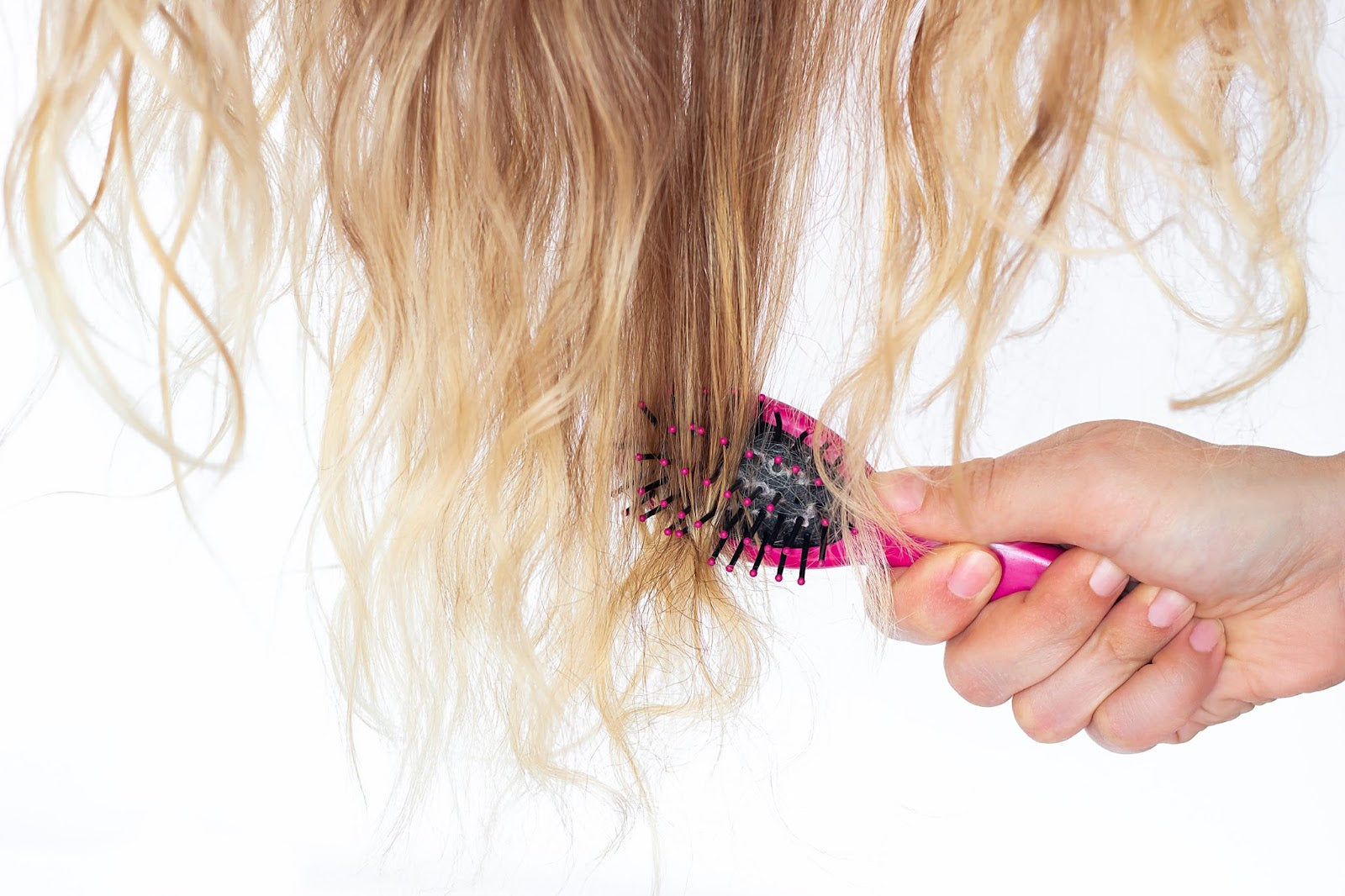Hair damage is an extremely common issue, and is caused by a variety of factors — from chemical treatments and heat styling, to water hardness and environmental factors like UV rays and cold temperatures.
To know whether or not your hair is damaged, look out for these signs:
- Frizzy or frayed split ends
- Brittleness
- Visible breakage
- Dull and lifeless hair
- Dry, coarse or difficult to style
Not only do these symptoms make your hair look less silky, but they can also affect the way it feels.
Unfortunately, there's no real way to "heal" or "repair" damaged hair because it's not alive and can't regenerate. However, the texture, manageability and look of your locks can be improved with the right custom hair care products. A few small changes to your routine can make a radical difference to the health of your hair now and in the future. With a little effort, you can help prevent and rebuild damaged hair.
How to Prevent and Rebuild Damaged Hair
When it comes to damage, prevention is always the best course of action. Here are seven key tips to help prevent and repair damaged hair. As you read through them, consider your own hair care routine and what changes you can make today.
- Understand your hair biology
- Cleanse correctly
- Be gentle with wet hair
- Lower the temperature on your heat tools
- Treat your hair care needs
- Reevaluate hair care each season
- Consider a haircut
1. Understand Your Hair Biology
The first step in preventing hair damage is understanding your hair biology. Everyone's hair is different, so what works for your friend, brother, sister, mom or dad might not work for you.
To find out what will work best for your one-of-a-kind hair, we recommend taking our free hair quiz — the Strands Test. With either the handheld Strands Smart Scanner located in select Walmart stores or the online Strands Test, you can get a detailed analysis of your hair biology and a regimen customized for your hair’s unique needs, in just a couple of minutes.
This is an important step, because it will help identify the products and treatments that are right for your hair type and needs. Using the wrong products can actually do more harm than good, so it's best to understand things like hair type and texture, and environmental factors such as UV index, humidity and water hardness before making any changes to your hair care routine.
2. Cleanse Correctly
Many people shampoo too often, which can actually strip your hair of its natural oils and lead to dryness and breakage.
Instead, we recommend shampooing every two to three days — or as needed — depending on your hair type. For example, if you have an oily scalp, you may need to cut shampooing back to once or twice a week to train your scalp to produce healthy amounts of oil. If you have straight or fine hair, you may need to wash more often to cut through any additional grime and keep your hair from falling flat.
When you do wash your hair, make sure to use a sulfate-free shampoo — such as a revitalizing or moisturizing shampoo — to avoid further damage. And be sure to follow up with a sulfate-free conditioner to help hydrate and protect your hair.
3. Be Gentle With Wet Hair
Wet hair is more vulnerable than dry hair, so it's important to be extra gentle with it. Avoid brushing hair when it's wet, as this can cause breakage. Instead, use a wide-toothed comb or a brush designed for wet hair.
You should also avoid rubbing wet hair with a towel. This can cause friction and lead to breakage. Instead, blot with a microfiber cloth or soft tee shirt.
And finally, avoid using elastic bands or tight hair ties when hair is wet. This can put unnecessary strain on your strands and cause breakage.
4. Lower the Temperature on Your Heat Tools
Another practical change you can make is to lower the temperature on your heat styling tools. We know it can be tempting to turn up the heat to get that perfect curl or straighten your hair more quickly, but this is one of the most common causes of heat damage. Instead, opt for a lower temperature setting and take your time. Not only will this help prevent damage, but it will also give you better results.
Additionally, you can look for heat styling tools that offer adjustable heat settings. This allows you to lower the temperature, which is especially important if you have fine-textured strands. However, most people should aim to keep their curling irons, flat irons, crimpers and other hair styling tools below the 350-degree threshold. Unless you have extremely thick or textured hair, mid-level temps will usually do the trick to get your desired style.
A good rule of thumb is: the finer the hair, the lower the heat . This is because fine hair is more delicate and can be easily damaged. Whether you have thick or fine hair, if you have to use heat, we recommend adding a Heat Defense D ose set to The Hair Lab shampoo and conditioner. This unique formula coats your strands to help defend against heat damage.
5. Treat Your Hair Care Needs
Just like your skincare routine, your hair care routine should be tailored to your specific needs.
If you have dry hair, you'll need to focus on hydration. If you have oily hair, you most likely have an oily scalp and need to focus on clarifying and balancing.
Once you know what your hair needs, you can start to build a tailor-made routine that includes shampoo, conditioner and other targeted treatments that can further customize your hair care. We recommend natural, sulfate-free hair treatments — such as the Moisture Boost Dose Set or the Anti-Breakage Dose Set — to avoid stripping hair of its natural oils. Of course, your test results will include specific recommendations, matched to your hair’s biology and needs.
6. Reevaluate Hair Care Each Season
Your hair also needs seasonal care. In the summertime, for example, salt water, chlorine and other chemicals can increase damage and cause your hair to become more fragile. In the winter months, when temperatures drop, you may experience a dry scalp or split ends.
Depending on how your hair responds to fluctuations in temperature and environment, you may need to switch up your hair care regimen to pre-empt problems. Another way to prevent damage is to protect your hair when outside by wearing a hat (the sun is still powerful in the winter!). If you have a trip planned somewhere warm, view our tips on how to protect your hair while on vacation.
7. Consider a Hair Cut
This can be a tough one for some, as we can all become attached to our hair. But if your ends are extremely damaged, sometimes the best solution is a really good trim.
This will allow you to get rid of all the damaged ends and start anew. Consult with a professional hairstylist to find out what kind of cut would be best for your hair type and face shape.
The good news is, once you've gotten the big chop, treating your hair with customized formulas matched to your hair biology and needs can work to prevent future damage, helping to keep your hair healthy-looking and requiring less frequent trims.
Damaged Hair Repair Tips: The Bottom Line

Your hair is one of your most important assets, so it's important to take care of it. At the end of the day, anything you do to minimize damage is a step in the right direction. However, by taking the Strands Test, customizing your hair care routine to match, and following our damaged hair repair tips, you can help rebuild your hair and prevent future damage.
So what are you waiting for? Test your hair today.

